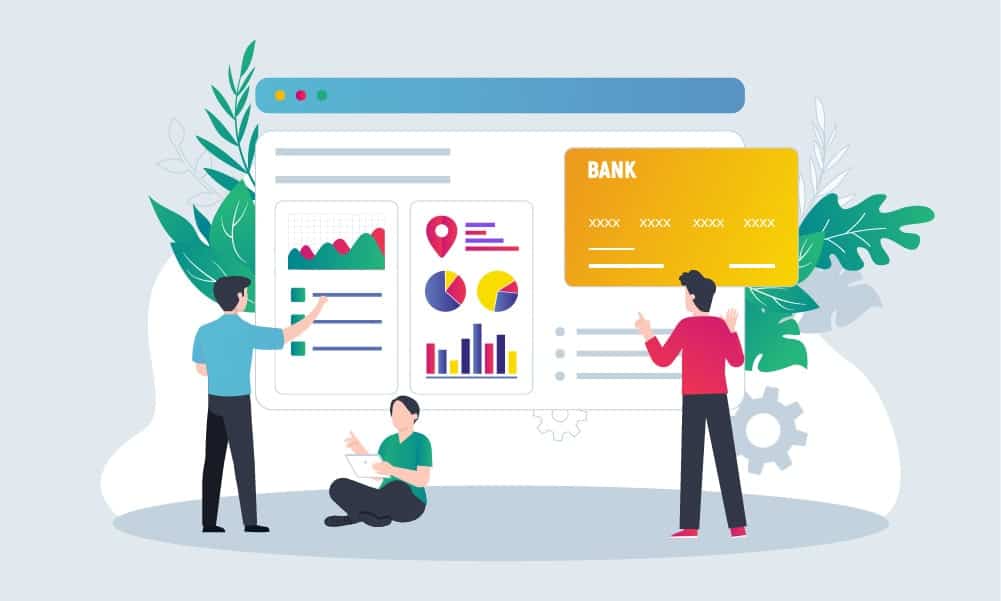There is no denying the fact that Big Data has taken over various industries: this technology benefits communication, healthcare, media, advertising, manufacturing, transportation, retail, etc. Big Data also changed the way financial institutions and businesses are performing their daily activities and competing in the market. It gives an opportunity to process, analyze, and leverage the information in useful ways and to understand the needs and expectations of potential clients.
This article delves into the intricate world of Big Data in financial services, exploring its definition, applications, and profound impact on the industry's landscape. Discover its influence on personalization, security, risk analysis, and investment strategies.
- What is Big Data in Financial Services?
- Use of Big Data in the Finance Industry
- Personalization
- Robo-Advisory
- Security & fraud detection
- Risk Analysis
- Stock market & investments
- What is the application of big data in finance?
- Forecast financial trends
- Analyze potential risks
- Automate core tasks
- Foster Inclusivity
- Consider Inoxoft Your Trusted Partner
- Final Words
What is Big Data in Financial Services?
Everything that surrounds us consists of data. John Mashey, a computer scientist from Pennsylvania, is considered to be the father of the term “Big Data”, in the mid-1990s talked about it at Silicon Graphics, an American company producing hardware and software up to 2009. Today Big Data is defined as a process of gathering and analyzing massive amounts of digital information to produce business intelligence.
Despite being a complicated matter, Big Data simplifies everything: from filtering the necessary information based on the client’s name to predicting possible risks.
The finance industry generates lots of structured and unstructured data.
Structured data is the information managed to provide key decision-making insights within an organization. Also, structured data is used in programming. It is divided into:
- machine-generated: weblogs, sensors, financial systems like medical devices, GPS data, server-captured statistics of usage, etc.
- human-generated: personal data that is input manually (name, details, etc.). This data is used by companies to track customer behavior and support decision-making in businesses, and, later, relevant modifications.
We believe it’s not a limit and we will hear about new features soon
- machine-generated: satellite images, scientific data, radar data
- human-generated: social media data, mobile data, website content
Use of Big Data in the Finance Industry
Let’s discover how Big Data may impact Fintech:
- With the ability to analyze huge amounts of data: financial services can improve customer service, customer targeting, and improve channel performance.
- Real-time data collection helps enhance security and prevent potential money theft or detect fraud in the banking industry.
- Data analytics enables businesses to gain valuable business insights that help in decision-making, risk management, product development, and more.
- The technology helps financial businesses revisit past performances, optimize ongoing tasks, and processes and get some vision of the future.
Research has shown that 71% of banking and financial firms that use information and financial data analytics have an advantage over their competitors. So, let’s take a closer look at big data use cases in financial services.
Learn more about augmented reality in the banking sector!
Personalization
Providing a high-quality user experience is a key to success in a competitive marketplace. There is a demand to understand who your clients are and sometimes predict their needs. Thus, financial institutions are switching their business models from business-centric to customer-centric.
Since more people use smartphones, especially to satisfy their financial needs, institutions like banks or insurance companies use big data to study thousands of their customer’s personal information from such sources as mobile banking history, social media, etc.
For instance, the AI-driven platform Slidetrade has been able to apply big data solutions to develop analytics platforms that predict clients’ payment behaviors.
Robo-Advisory
Effective implementation of Robotic process automation (RPA) in financial services can result in better efficiency, fewer errors, and higher workforce productivity. According to the report, the finance digital workforce is growing: 50% of controllers are in the process or have already implemented robotic process automation, and the number is predicted to increase to 88% over the next two years. Juniper states that the revenue from Robotic Process Automation in Fintech is expected to grow by $1 Billion by 2023.
What does this mean for financial institutions?
- Maintain data consistency. Software bots keep customers’ details updated (names, addresses, credit scores, etc)
- Accounting. RPA minimizes errors while saving human employees the effort to do data entry or data gathering. Probably anyone who has ever worked in accounting knows that the effects of errors can be daunting, but also that it’s quasi-impossible to avoid them when you have to spend neverending hours entering data.
- Use of big data in banking. Software robots can serve as financial advisors with the ability to track investment values, assess an investor’s portfolio, facilitate access to the stock market, and minimize the risk of investing. An example is the Colombian bank Bancolombia, which has launched InvesBot to give clients investment recommendations by sending updated information about clients’ portfolios, stock positions, economic events, price changes, market conditions, etc.
- Tax Reports. Gathering and settling tax-related data is a challenge for many financial institutions, RPA bots can be placed in charge of gathering data, preparing reports, calculating the tax payable, and submitting filings to tax authority portals.
In general, these software bots can minimize human interactions with a digital system. Usage also includes risk assessments, security checks, data analysis and reporting, compliance processes as well as most other repetitive administrative activities. This gives financial institutions more time and workforce to perform their core responsibilities.
Security & fraud detection
Privacy protection is a major concern tied to the implementation of cloud computing technologies. With the ongoing progress in fintech, cyberhackers are coming up with new methods of cyber fraud. Hence, security should not be underestimated. To ensure data protection software developers control if their projects meet legal standards e.g. General Data Protection Regulation (GDPR).
In the present scenario, Financial Institutions deal with customers’ data regularly. Not only the information is critical, but very valuable since it gives insights into the daily operations of the bank. Considering the sensitivity of the data, there is a persistent need to evaluate the stored data and protect it from fraudulent activities, while ensuring the risk is reduced drastically.
Machine learning, fueled by big data, is responsible for fraud detection and prevention. The security risks once posed by credit cards have been mitigated with analytics that interpret buying patterns. Now, when secure and valuable credit card information is stolen, banks can instantly freeze the card and any fraudulent transactions, and notify the customer of security threats.
Risk Analysis
The use of big data analytics in the finance sector to identify important trends and potential risks can help financial organizations make better strategic decisions. Questions like investments and loans now rely on technology such as Machine Learning. ML uses algorithms and various techniques to teach computers to act on data. It learns from an amount of information, understands specific data patterns, and builds predictions based on these patterns. Decisions based on predictive analytics take into account everything from the economy and business capital to identify potential risks like bad investments. For instance, banks use different big data platforms and technologies example to build risk platforms, where unstructured data is mined. Big data technology is used on the company’s trading and risk data (collected over 10 years).
Stock market & investments
Big data is changing the way stock markets are functioning and how venture capitalists are making their investment decisions. Machine learning – the practice of using computer algorithms to find patterns in massive amounts of data – is enabling computers to make accurate predictions and human-like decisions when fed data, executing trades at rapid speeds and frequencies.
Big data analytics monitors stock trends and incorporates the best prices, allowing analysts to make better decisions and reducing manual mistakes. Access to big data and improved algorithmic understanding result in more precise predictions and the ability to effectively mitigate the inherent risks related to financial trading.
What is the application of big data in finance?
In financial services, data analytics means a lot. Everything you can do in advance, automate and predict is by weight of gold. For instance, with the application of big data in finance, you can:
Forecast financial trends
Predictions of future trends before they occur are one of the major benefits of big data analytics for financial services. What might be the advantages of these future insights? You can be aware of the negative trends and not follow them. Or you can pick up a positive trend and be on top of your competition. Besides, having specific financial data in your hands allows you to make decisions about future products, services, and investments. And financial data analytics makes you able to consult your clients on their business processes.
Analyze potential risks
Big data analytics in the banking industry also makes it possible to be aware of your business’s potential risks. And, you can consult clients on their risky situations as well. With machine learning algorithms, risky investments are pointed to relatively quickly. This is a major opportunity not to fall for bad financial decisions and think twice before engaging in a financial disaster.
Automate core tasks
With the help of automation, you can manage any financial task with increased speed, performance, and value. Employees like analysts, managers, and associates can do any trivial tasks much faster, better, and with more efficiency. This also increases customer satisfaction. Customers will get online assistance or digitally perform tasks. For instance, autofill of forms, signing of papers, or getting financial transactions via a smart system will make them more engaged and tech-savvy.
Foster Inclusivity
Equality is quite the topic these days. And it is common sense to treat each individual equally despite their race, sexual orientation, or gender. So, with data analytics in financial services, it is possible to achieve transparency, qualification, no discrimination or prejudiced attitude, etc. machine algorithms have no differentiation. They exist to help and they help banks do the right job.
Consider Inoxoft Your Trusted Partner
Inoxoft has deep knowledge and focuses on big data analytics services. With predictive analytics in big data, we can perform valuable data analysis for banking and finance software solutions. What does it give you? Insightful information on future trends, automation of financial processes, transparency, and accessibility will enhance your customer satisfaction. Big data use cases in banking are numerous. Ask us to carry out a specific financial project for you and we will get the job done right.
Consider Inoxoft as your financial big data analytics provider. Our skilled teams are great at providing machine learning in fintech services. Request for a proposal. Contact us for a free consultation. Inoxoft is more than happy to enhance your business flow and put you ahead of your competitors.
Final Words
In the coming years, more and more financial institutions are expected to leverage data analytics to control and regulate data to build efficient, smarter businesses and receive new opportunities. If you’re ready to take advantage of big data for your financial institution or get strategic insights, we can give you a hand. Book a call with our CTO Brad Flaughter here to receive outstanding big data financial analysis and big data in financial services.
Frequently Asked Questions
What is big data analytics in finance?
The finance industry generates lots of structured and unstructured data. This is called big data. And there is a possibility to analyze it to predict future banking trends and be aware of the financial institution’s growth opportunities.
What is the application of financial data analytics in the banking industry?
You can apply big data analytics in financial forecasting, risk analysis, task automation and while fostering inclusivity.
What is the use of big data in financial services?
In Robo-advisory, personalization of data, fraud detection, extra security, investments, and stock market transactions or forecasting.











